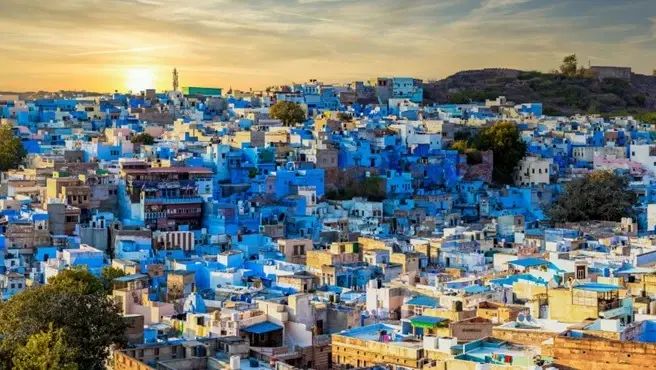
Flights
•04 min read

Imagine wandering through narrow lanes lined with dazzling blue houses that seem to sparkle under the sun—a vision that sparks curiosity and inspires adventure. Villages painted in blue captivate travelers worldwide, from the whimsical transformation of Spain’s Juzcar, famously known as a village transformed for a popular animated film promotion, to the serene blue medina of Chefchaouen in Morocco, and even traditional blue-painted homes found in Dhudaly, Rajasthan, India. This blog post answers frequently asked questions about these enchanting destinations, delving into their history, cultural significance, and the unique appeal that draws visitors from around the globe.
Villages painted in blue are communities distinguished by buildings and structures adorned entirely or predominantly with blue hues. These blue-painted villages feature architecture that is often steeped in cultural or historical significance, blending traditional techniques with natural pigments to create a visually mesmerizing landscape. Their blue facades not only define the aesthetic of these towns but also tell tales of heritage and innovation.
Consider Juzcar in Spain, a village that was once whitewashed and later transformed into a vibrant blue setting to promote a popular animated film. Over time, its blue charm has earned it a permanent identity among blue-themed villages. Across the Mediterranean in Morocco lies Chefchaouen, often referred to as the Blue Pearl, where every corner reflects cultural symbolism and artistic traditions. Meanwhile, in India, the village of Dhudaly, Rajasthan is known for its traditional blue-painted homes, celebrated for their heritage and architectural uniqueness.
The choice of blue in these villages often roots back to rich historical and cultural narratives. In many cases, the blue hue carries spiritual connotations; for example, in Chefchaouen, the blue walls are believed to symbolize spirituality in Judaism and serve as a constant reminder of faith and tradition.
Another compelling reason behind the adoption of blue is its role in tourism and branding. The transformation of Juzcar for a popular animated film campaign is a prime example, where the village embraced a new identity to attract curious travelers. Over time, this modern branding strategy merged with local culture, turning a temporary trend into a celebrated, permanent feature.
Furthermore, practical considerations also play a role in the choice of color. The use of natural blue limewash can help keep buildings cool during hot climate spells and is believed to help ward off insects. This blend of practicality with tradition underscores the multidimensional reasons behind painting these villages blue.
Blue architecture and the vibrant shade of blue have left their mark on regions across the globe. In Europe, Juzcar stands out with its quirky transformation that has become a tourist attraction. In Asia, Dhudaly in Rajasthan offers a glimpse into traditional life, where blue-painted houses echo a rich cultural history. Meanwhile, in Africa, Chefchaouen mesmerizes visitors with a coastal palette of various blue shades, infusing the landscape with a sense of calm and mystery.

These villages are celebrated for their use of naturally derived pigments and traditional painting techniques. The interplay of local artistry and practical functionality creates architectural masterpieces that are not only aesthetically pleasing but also deeply connected to the local way of life.
Visiting blue-painted villages offers more than just a picturesque backdrop—it’s an invitation to immerse oneself in the local culture and heritage. Travelers are urged to visit during the best seasons; for instance, the mild spring weather in Chefchaouen enhances the experience, making it perfect for photography, local walks, and explorations of the surrounding natural beauty.
While sightseeing and taking breathtaking photos, tourists should also be mindful of the impact their visits can have on these delicate communities. Support for local artisans, tasting the authentic local cuisine, and participating in cultural festivals can enrich your travel experience while ensuring a sustainable and respectful interaction with the environment.
Juzcar, Spain, was originally a whitewashed Andalusian village before being painted entirely in blue for a popular animated film promotion in 2011. The transformation was so popular that the villagers voted to keep it blue permanently!
The charm of blue-painted villages is best appreciated when compared with other colorful destinations around the world. For instance, while Spain's Villajoyosa is celebrated for its vibrant houses in a rainbow of hues, blue villages like Chefchaouen offer a more unified, yet equally compelling, narrative of tradition and artistry.
The cultural significance of color in architecture cannot be overstated. In these villages, blue represents not just a choice of hue but an expression of collective identity, creativity, and pride. This color, historically associated with protection and spirituality, continues to enhance the uniqueness of these communities.

Juzcar was painted blue in 2011 as part of a promotional campaign for a popular animated film, and its popularity led the villagers to keep it blue permanently.
Yes, other blue-themed villages include Juzcar in Spain and Dhudaly in India, each carrying its own cultural and historical narrative.
Their unique, picturesque appearance paired with rich cultural and historical backgrounds makes them highly appealing for both photography and cultural exploration.
Respect local customs, avoid littering, and support local businesses to ensure that tourism remains sustainable and beneficial to the community.
In some cases, blue paint helps repel insects and keeps buildings cool in hot climates, adding a functional layer to its aesthetic appeal.
Villages painted in blue are more than just scenic escapes; they are vibrant testimonies to cultural heritage, practical innovation, and the innate human love for beauty. From the storybook ambiance of Juzcar to the soulful blue corridors of Chefchaouen, each village offers a unique journey into art, history, and community spirit. Whether you are seeking inspiration for your next adventure or a deeper understanding of colorful cultural narratives, these blue architecture villages reveal the diverse tapestry of global civilization.
What are your thoughts on these mesmerizing blue villages? Share your experiences or favorite destinations in the comments below!